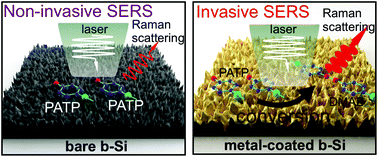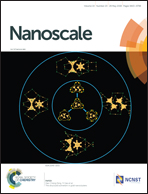Chemically non-perturbing SERS detection of a catalytic reaction with black silicon†
Abstract
All-dielectric resonant micro- and nano-structures made of high-index dielectrics have recently emerged as a promising surface-enhanced Raman scattering (SERS) platform which can complement or potentially replace the metal-based counterparts in routine sensing measurements. These unique structures combine the highly-tunable optical response and high field enhancement with the non-invasiveness, i.e. chemically non-perturbing the analyte, simple chemical modification and recyclability. Meanwhile, commercially competitive fabrication technologies for mass production of such structures are still missing. Here, we attest a chemically inert black silicon (b-Si) substrate consisting of randomly-arranged spiky Mie resonators for a true non-invasive (chemically non-perturbing) SERS identification of the molecular fingerprints at low concentrations. Based on the comparative in situ SERS tracking of the para-aminothiophenol (PATP)-to-4,4′-dimercaptoazobenzene (DMAB) catalytic conversion on the bare and metal-coated b-Si, we justify the applicability of the metal-free b-Si for ultra-sensitive non-invasive SERS detection at a concentration level as low as 10−6 M. We performed supporting finite-difference time-domain (FDTD) calculations to reveal the electromagnetic enhancement provided by an isolated spiky Si resonator in the visible spectral range. Additional comparative SERS studies of the PATP-to-DMAB conversion performed with a chemically active bare black copper oxide (b-CuO) substrate as well as SERS detection of the slow daylight-driven PATP-to-DMAB catalytic conversion in the aqueous methanol solution loaded with colloidal silver nanoparticles (Ag NPs) confirm the non-invasive SERS performance of the all-dielectric crystalline b-Si substrate. A proposed SERS substrate can be fabricated using the easy-to-implement scalable technology of plasma etching amenable on substrate areas over 10 × 10 cm2 making such inexpensive all-dielectric substrates promising for routine SERS applications, where the non-invasiveness is of high importance.



 Please wait while we load your content...
Please wait while we load your content...